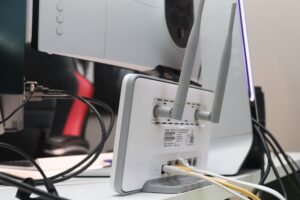
How DNS and DHCP Performance Impacts the Overall WiFi Network and Business Continuity

Domain Name System (DNS) and Dynamic Host Configuration Protocol (DHCP) servers are two of the most important pieces of infrastructure for any organization. Keeping them secure and reliable is a high priority for CIOs and IT teams.
Here is a top-level look at what these servers do, how they impact business continuity, the threats they face, and budget-friendly ways to keep them optimized and future-proofed.
What is a DNS server?
DNS servers translate domain names (URLs) into IP addresses so that other servers know where to route internet traffic. Without these machines, queries from client devices such as laptops, mobile phones, and IoT devices would go nowhere as servers would have no way of understanding what website clients wanted to reach.
What optimized DNS performance looks like
High performing DNS servers are easy to spot. Companies know they have top-notch infrastructure when all web queries are resolved in milliseconds, over and over and over again. There should be no delays, no “timeout” messages, and no lost connections.
To protect performance, organizations should have multiple servers. Two or three are generally recommended. With this setup, if one server misses a request or fails, the second or third servers are in place to safeguard the user experience and business continuity.
These servers are constantly in use, so optimizing them is important.
Common DNS server issues
DNS servers can fail for any number of reasons from accidental, like power outages or misconfigurations, to intentional – cyberattacks like the 2016 attack that targeted Dyn, a DNS provider for many international sites. Some issues will lie internally, while others might need to be fixed on the provider’s end. Some can be resolved quickly, while others will require extra resources and time.
Whatever the issue, the end result is the same: users unable to view Web pages, something that can quickly spell disaster for business continuity. If outside customers and internal employees can’t access a company’s website, or the many sites needed for job performance, daily business operations come to an abrupt halt.
However, while the result may be the same, all issues can’t be resolved the same way. Implementing the correct troubleshooting steps requires IT teams to know the root cause of the problem. This can be a time-consuming process all on its own.
To speed up the process without sacrificing efficacy, IT teams can use a WiFi automation platform for real-time alerts that include root cause identification. See below for more details
What is a DHCP server?
When a client device joins the WiFi network, it has to get an IP address in order to use all services. DHCP servers provide and assign those addresses as well as other needed configuration parameters such as the subnet mask and default gateway. Without a DHCP server, this information must be manually assigned.
To prevent an IP address being assigned to more than one device, organizations have only one DHCP server.
What optimized DHCP performance looks like
When the server assigns IP address information to a device, that information is only valid for a limited period of time. This is known as a DHCP lease.
Under optimized conditions, there must be:
- Enough IP addresses available for all devices
- Lease times must be configured to meet device needs – i.e. longer lease times for permanent devices and shorter lease times for guest devices
The server must respond quickly to all requests so that business can continue. Requests include:
- Initial requests for an IP address and other configuration parameters
- A request to extend the lease of a current IP address
- A request after a reboot to determine if a device can use the same IP address it was using before the reboot
If a device needs a permanent IP address so that other devices always know how to find it – for example, a WiFi-connected printer – IT teams can use DHCP Reservation to ensure that device always gets the same IP address.
Common DHCP server issues
If there are problems with the DHCP, IT teams will receive reports of failed connections or long connectivity times. These can be caused by:
- A server that has run out of available IP addresses
- A server that has assigned the same IP more than once (even though organizations use only one DHCP to avoid this, it can happen)
- A server that doesn’t provide the complete information
- A server that has failed
- A larger issue with the server’s WiFi network
Much like DNS issues, troubleshooting can be challenging and time consuming. A WiFi automation platform will simplify the process. Let’s take a look at how these platforms work.
How to test DHCP and DNS performance
Testing can be performed manually or automatically. Automatic solutions offer several benefits, including:
- 24/7 runtimes for the most comprehensive insights
- Scheduled testing frees up IT for other critical tasks
In addition to the above, Wyebot’s Wireless Intelligence Platform™ (WIP) includes a Synthetic Network Test Suite that delivers:
Real time, automatic alerts
If a test fails for any reason, including if it falls outside of established parameters, an alert is sent. This allows IT to begin resolving the issue immediately, often before end users are impacted.
Identified root cause
With so many possible root causes to an issue, the faster IT knows exactly what happened, the faster they can troubleshoot. Root causes can be:
- Internal
- External
- Directly related to the server
- Related to other infrastructure such as routers, switchers, APs, firewalls, etc.
If IT teams have to manually capture packets and review them to find the root cause, it can significantly increase resolution times. An automatic process saves everyone time and money.
Actionable resolutions
These further reduce resolution times, allowing IT professionals to see what can be done to resolve server issues quickly so that they do not occur repeatedly.
Vendor agnostic design
WIP is vendor agnostic so that it can be used by IT at all sites, no matter how WLAN vendors change.
Automatically saved historical wireless analytics
With this capability, IT can review performance from the past day, week, or month. This look at long-term performance trends allows professionals to more effectively plan upgrades and updates to future-proof servers and the overall WiFi network.
Remote access
Remote access lets IT schedule tests and troubleshoot issues from any time and any location.
WIP’s DNS server test, which also tests the DHCP, is set by default to run every 20 minutes. While this schedule can be adjusted, and while manual tests can be run at any time, the more often servers are tested, the better. These critical pieces of infrastructure are in constant use and the earlier problems are automatically discovered and identified, the more user experience will be improved.
With WIP, organizations see:
- 90% faster Mean-Times-to-Resolution
- 70% fewer WiFi problem tickets
- 80% fewer remote site visits
This directly results in lower costs and improved performance for all customers. To bring WIP to your organization, start with a free demo or trial today.


